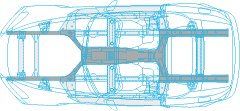 |
Perfect numbers
: 50 : 50 |
 |
Perfect numbers
: 50 : 50 |
"As Rigid
as a Sedan" claimed Honda.
  For an open top Roadster, side impact protection is usually provided by strengthening door sills, which inevitably raise the sills thus making in and out more difficult. S2000'd rather strengthen the chassis rails by connecting them to the central transmission tunnel. This forms a "X-bone". As the transmission tunnel is even higher than side sills, it provides even higher rigidity. |
Time TunnelAdolf Hilter's Beetle We heard Dr. Ferdinand Porsche created the Volkswagen (not yet called Beetle before British took over the Wolfsburg plant in 1946) under funding from Hilter. During world war II, the Volkswagen was converted to military vehicle serving Nazer's army in North Africa. Its air-cooled engine suited for use in desert. The picture shows one of these cars captured by British forces in Lybia, 1943. |
What
an Ad !  It's not your
eyesight that
needs testing.
|
Reader's Letter |
||||
|
|
|||
| This year, Sport Utility Vehicles are going to
account
for nearly 60% of USA’s new car sales. What’s more, the trend is still
growing. These popular SUV consists of 4-wheel-drive offroaders and
pickups,
usually weighing in excess of 2 tons. I can’t quite understand the
American
love affair of these monsters.
A typical family of a developed country consist of 4 members and 2 cars, one for the husband and one for the wife. In United States the car to people ratio is even approaching 1. Most people live in cities or country side nearby. And the call for environmental protection is increasing year by year. Considering such background, what modern human need is a small car being able to carry 4 people and weighing no more than 1000kg, drinks 3 litres of gas for every 100 kilometers and with a dimension to enable parking at ease. SUV ? No way. Surveys confirmed that most of the time your vehicle carries only 1 or 2 people including you, this makes a 2 tons SUV nonsense for everyday use. Instead of SUV, the most logical vehicle is a 2-seater named Smart. Commercially it has been proved as a failure, but I maintain that the failure is due to overprice and its flaw technical design, not because of the concept as a tiny city car. Anyway, SUV is never the most efficient way to move people. There are many MPV can carry 7 people with comfort. They tip the scale at 1500-1700kg, with all independent suspensions and multi-valve V6 but without the gas-wasting 4-wheel-drive. What SUV wins over MPV is off-road ability. It is understandable that the agricultural area of Southern USA need SUVs to travel on muddy roads, but when you see SUV also dominates the streets of Los Angeles, New York and the Silicone Valley you know the world is really going crazy. Among all these SUVs, how many of them really need to go offroad ? Anyone have been in Hong Kong must know that this city never need SUVs. However, Rover Discovery and Mitsubishi Pajero are common scene in here. Most people use them to travel to picnic sites nearby (just |
behind the city), but every time I saw them I
can’t find
any mud on their body. Moreover, the roads to countryside are better
than
most British or French country roads, at least there is cement covering
the surface.
Someone said they want SUV for all-weather ability. Pardon ? It’s not the question of SUV, it’s about 4-wheel-drive only. A Subaru Legacy goes as well on wet or snow while providing superior handling and ride comfort. Moreover, even the Swedish are not very keen about 4-wheel-drive, as you can find only the minority of Volvo S70 equips with 4wd. Ridiculously, the most SUV-alike Swedish car is the Volvo V70XC, which is primarily designed for the US market. Another popular reason for defending the SUV is the superiority of crash protection. All of us know big cars (or more accurately speaking is heavy car) transfer less force to the occupants than small cars during a crash, simply because of the conservation of momentum. Therefore a 2.5 ton SUV crash face to face to a 1 ton Civic must favour the former. In other words, we can also say the popularity of SUV is harming other conventional road users. However, a SUV crash into another SUV won’t be so good. The law of conservation of momentum won’t favour any one of them, so both will be hurt severely, although the larger crumble zone of SUV still has an edge over normal cars. One day, when every car on the road become SUV, you might see a new trend of BUV (Bus Utility Vehicle) start, each weighing in excess of 10 tons in order to have superior crash protection against SUV, just like today’s SUV versus normal cars. Undoubtedly, to upgrade safety by means of adding weight and size is nonsense. Since there is not a single reasonable explaination for the popularity of SUV, I can’t help thinking this is a fashion driven by emotion. A friend of mine told me she was dreaming for a Jeep (she even didn’t know "Jeep" is a brand name rather than a term equivalent to off-roader.) Why ? "It looks cool !" replied her. I guess most other people think the same. They want SUV not because of any |
practical reason but because they like the idea.
An example
is Toyota RAV 4, which once dominated here before the arrival of CR-V.
It could win any beauty contest but off-road ability is nearly zero.
The
same for CR-V and HR-V. In here and Japan, a large portion of the sales
of Lexus RX300 are the front-wheel-drive version, the conclusion
couldn’t
be clearer.
For "cool look", American is paying heavy price : inferior performance inspite of heavyweight engine, awful handling, poor ride from the non-independent or even leaf spring suspensions, premium price (profit margin is much higher than other cars) and most important is the impact to environment. You might not know, in the US SUVs are excluded from the emission regulation for normal cars. They have a regulation allowing much more pollutant. Right now the Clinton government is planning to raise the requirement for SUV to align with cars. Undoubtedly, Big 3 is protesting against this so it is unlikely to be fully effective until 2007. Even by 2007, Federal emission regulation does not limit the so-called "non-pollution gas" - carbon dioxide, which leads to green house effect to not only US but all over the world. No matter how clean the engine is, the amount of CO2 emission is always proportional to fuel consumption. With their 2 tons weight and old technology engines, SUVs are inherent enemies to fuel efficiency as well as the environment. 2 years ago an international environment conference focused on the emission of CO2, during which the US government was pressured by EU and Japan to accept a strict time table to reduce CO2 emission. With the popularity of SUV still growing, this target will never be fulfilled. The root of the problem is fuel price. Nowhere in the world, excluding oil-export countries, has gas price lower than the US. Low fuel price policy leads to big engines, big cars and big SUVs. Pershaps the US need another oil crisis to force car makers return to develop compact cars, small and fuel-efficient engines. - Mark Wan.
|